Charging your wearable overnight poses several health concerns. You’re exposing yourself to electromagnetic radiation that can disrupt sleep patterns and risking fire hazards from overheating batteries. Your device’s battery degrades faster when left charging for hours, and unsecured wearables may leave your personal data vulnerable. Placing hot devices on your skin can cause irritation. Smart charging habits can protect both your health and device investment.
Fire Hazards and Overcharging Risks During Nightly Charging
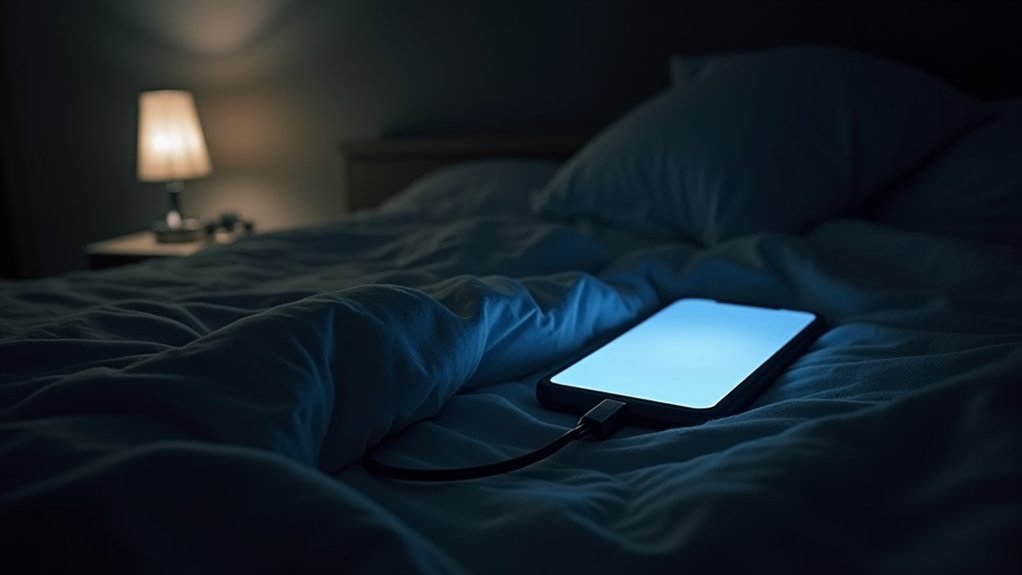
While modern devices include battery protection systems, the practice of charging wearables overnight creates significant fire hazards that many users overlook.
Lithium-ion batteries, especially degraded ones in older devices, are susceptible to thermal runaway—an uncontrollable temperature spike that can lead to fires.
When you charge your wearable under pillows or on soft surfaces, you’re blocking heat dissipation and accelerating thermal buildup. This is particularly dangerous since over one-third of teenagers place phones under pillows while charging.
The risk increases with non-certified chargers that deliver inconsistent currents. Always use manufacturer-approved chargers to minimize toxic chemical exposure from potential battery fires.
Don’t assume safety features will prevent all accidents. Charging on flammable surfaces like wooden bedside tables amplifies fire spread risks, giving you little time to react if a fire starts.
Electromagnetic Radiation Exposure While You Sleep
Every night you charge your wearable device, you’re exposing yourself to electromagnetic radiation during your most vulnerable hours. Your smartwatch or fitness tracker emits non-ionizing radiofrequency radiation, which research suggests may disrupt your sleep patterns.
Studies show this exposure can increase brain activity during non-REM sleep—when your brain should be resting—potentially leading to clinical insomnia. The radiation might alter your sleep stages by affecting gamma, beta, and theta waves, while the device’s screen light can suppress melatonin production. Recent research indicates that RF-EMF exposure significantly reduces sleep quality compared to sham conditions in controlled studies.
Research indicates nighttime radiation exposure disrupts crucial sleep cycles by stimulating brain activity during rest periods.
To minimize risks, consider placing your charging device farther from your bed, using airplane mode overnight, or creating a screen-free bedroom environment.
Some shielding materials can also block RF radiation, offering additional protection during your critical recovery hours.
Privacy Concerns When Wearables Charge Unattended

Your charging smartwatch isn’t as secure as you might think, creating opportunities for hackers to access your personal data while you sleep.
Unattended wearables can silently transmit your location, health metrics, and device activity to unauthorized third parties throughout the night. Users should implement strong data protection measures to safeguard sensitive health information collected by their devices.
Your private information, including sleep patterns and heart rate data, becomes particularly vulnerable when devices remain connected to networks during overnight charging sessions.
Unattended Security Vulnerabilities
When left charging overnight, your wearable devices become vulnerable to a range of security threats that can compromise personal data. Most wearables lack PIN protection and proper encryption, making them easy targets if physically accessed or stolen while charging. With less than 10% of wearables currently equipped with necessary cybersecurity features, the risk of data breaches is substantially higher than most users realize.
Your device’s Bluetooth connection creates additional risks, as unattended wearables can be exploited to gain backdoor access to paired smartphones. Without multi-factor authentication, attackers can potentially hijack ongoing sessions and access linked accounts.
The charging process itself introduces vulnerabilities—public charging stations may execute “juice-jacking” attacks, while wireless charging on unsecured networks exposes your data to interception.
Many manufacturers prioritize convenience over security, using proprietary or outdated encryption protocols that leave your health information exposed to unauthorized access during overnight charging periods.
Nighttime Data Harvesting
Most connected wearables transmit health and activity data silently while charging overnight, often without users’ knowledge or consent. Your sleep patterns, heart rate, and activity metrics are typically uploaded to cloud servers, where they may be vulnerable to unauthorized access if security measures fail.
While some devices store data locally, many use cloud storage with varying encryption standards. You’re likely unaware of exactly what information is being shared and with whom during these charging sessions. Companies might share your data with third parties according to privacy policies you’ve never fully read. The increasing reliance on wearables for sleep and circadian research has led to expanded autonomic parameters being collected during overnight charging.
To protect yourself, check your device’s privacy settings, enable two-factor authentication, and review the manufacturer’s data handling practices.
Consider wearables that offer edge computing options, which process more data on the device itself rather than sending everything to the cloud.
Silent Location Tracking
Despite appearing dormant, charging wearables often maintain active location tracking capabilities that continue to monitor your whereabouts.
While you sleep, these devices silently gather GPS data, building detailed profiles of your home layout and routines.
You probably assume your device stops tracking when it’s charging, but most manufacturers keep location services running by default. Wearables create an expanded attack surface for hackers who can exploit these always-on connections.
This creates privacy vulnerabilities as your wearable transmits data through potentially insecure charging stations or wireless pads.
This passive collection happens primarily during overnight charging—exactly when you’re least able to monitor device activity.
With limited UI indicators and vague privacy policies, you’re unlikely to notice this background surveillance.
The risks increase with newer wearables that incorporate advanced sensors and 5G connectivity, enabling faster data transmission and more precise location inference during these unattended periods.
Battery Degradation From Consistent Overnight Charging Cycles
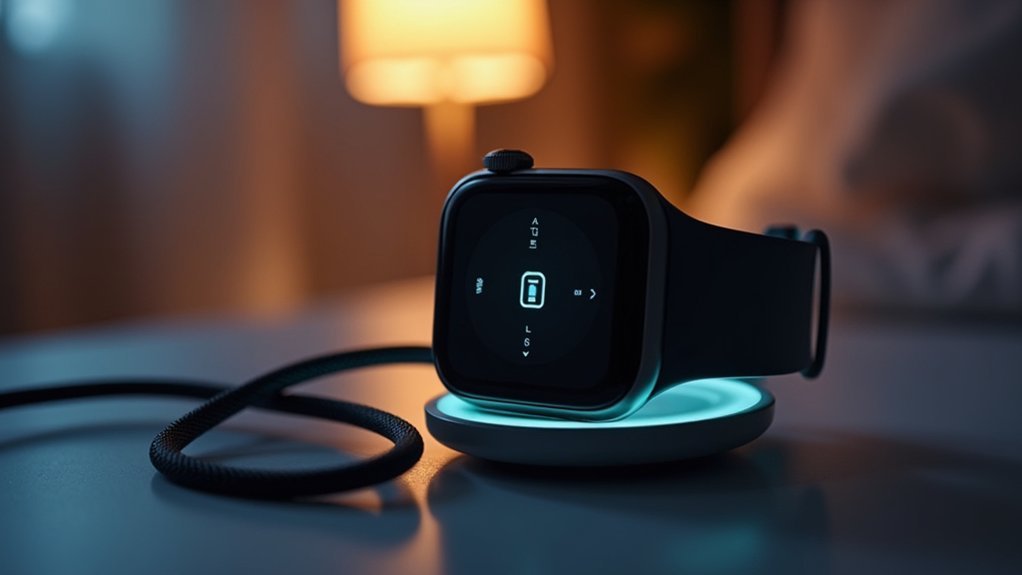
Although many people habitually plug their wearable devices in before bed, consistent overnight charging can greatly accelerate battery degradation.
Your device’s lithium-ion battery suffers when kept at high voltage states for extended periods.
Maintaining your battery at high voltage for hours is like subjecting it to prolonged stress – damaging its internal chemistry.
When you leave your wearable charging all night, you’re subjecting it to incomplete charge cycles while maintaining it at near-full capacity for hours. This practice considerably reduces battery lifespan over time. If overnight charging is unavoidable, using a slow charger can minimize potential damage.
For ideal battery health, keep your charge level between 20% and 80%.
Instead of overnight charging, try topping off your device during the day. Each full discharge and recharge counts as one cycle that contributes to wear, so partial charging actually extends battery life.
Temperature Management and Heat-Related Safety Issues
Wearable devices can become dangerously hot when charging overnight, creating potential fire hazards and accelerating battery deterioration. This risk increases when you place devices on soft surfaces like beds or pillows that trap heat and prevent proper ventilation.
Your unattended charging wearables pose significant risks while you sleep, as fires can develop without your awareness. The Finnish Brain Association now recommends charging only during waking hours for safety.
Heat not only damages batteries but may disturb your sleep quality through thermal discomfort and electromagnetic emissions. Quality charging gear prevents overcharging issues and helps maintain optimal battery health during overnight charging sessions.
To minimize these risks, always charge your wearables on hard, flat surfaces with good ventilation. Wireless charging generates more heat than wired methods, so consider this when deciding how to power your devices overnight.
Optimizing Charging Habits for Healthier Usage Patterns
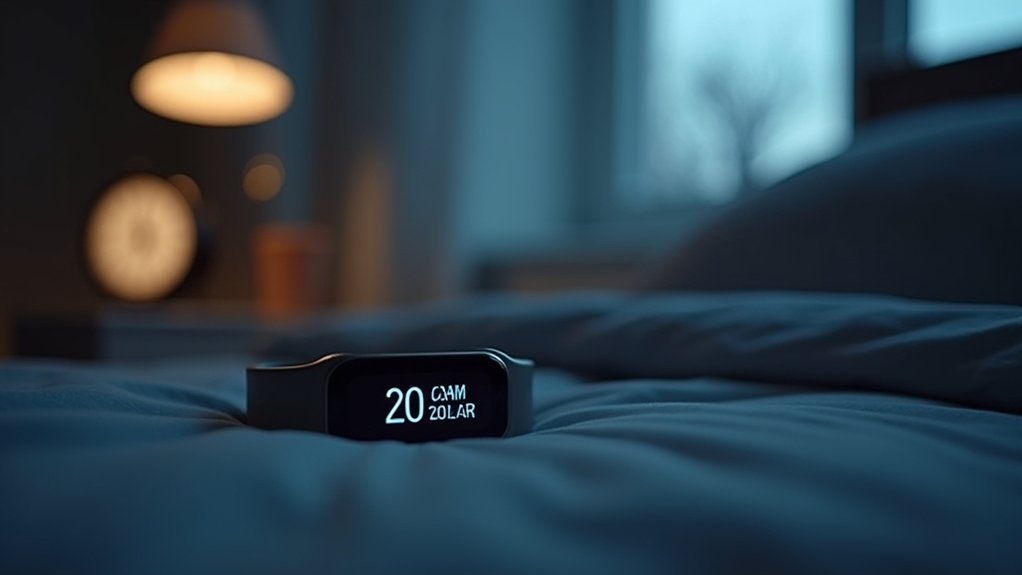
Establishing healthier charging habits for your wearable devices requires a deliberate approach that balances convenience with safety.
Create device-free zones in your bedroom and set up a dedicated charging station away from your sleeping area to minimize sleep disruption and EMF exposure.
Designate a charging hub outside your bedroom to create sacred sleep spaces unaffected by digital distractions and electromagnetic fields.
Try charging your wearables during daytime hours when you’re less likely to need them, such as while showering or during desk work. This prevents the compulsion to check devices at night.
Consider implementing a digital curfew—charge your devices to at least 80% before bedtime, then switch to airplane mode or power them off completely. Charging devices overnight significantly increases fire hazards when devices are left unattended for long periods.
Regularly inspect your chargers for damage and use only certified equipment that meets safety standards.
These small adjustments can considerably improve both your sleep quality and overall well-being.
Industry Safety Standards and Manufacturer Guidelines
Despite widespread reassurances, you’ll find significant gaps in regulatory frameworks that fail to adequately address long-term EMF exposure from overnight wearable charging.
Many manufacturers sidestep full corporate responsibility by meeting minimal safety requirements while ignoring potential cumulative health effects from prolonged exposure.
The certification process itself suffers from industry-influenced testing parameters and lacks independent verification protocols for real-world sleeping environments. While the FCC and FDA establish safety standards for EMF-emitting devices, current standards may not fully account for the possibly carcinogenic classification that the WHO has assigned to low-level, non-ionizing EMFs.
Regulatory Framework Gaps
While consumer electronics safety frameworks exist for various devices, a notable gap persists in the specific regulation of wearable technology during overnight charging.
Current standards don’t address real-world scenarios like charging wearables under blankets or in prolonged skin contact.
You’ll find inconsistent guidelines across manufacturers—Apple discourages charging phones in bed but offers no equivalent warnings for Apple Watch.
Testing methodologies rarely account for common sleeping conditions that could trap heat or increase EMF exposure during 6-8 hour charging periods.
The regulatory landscape also lacks clear requirements for fail-safe mechanisms that detect skin contact during overheating events.
This regulatory gap is particularly concerning since wireless chargers produce low-frequency EMF radiation that may accumulate during extended overnight charging sessions.
Without standardized protocols for wireless charging interoperability, you’re left maneuvering through conflicting safety information and potential risks that remain inadequately addressed by current frameworks.
Corporate Responsibility Shortcomings
The regulatory gaps in wearable safety extend directly to corporate practices where manufacturers have largely failed to establish extensive guidelines for overnight charging.
You’ll find most device manuals lack explicit warnings about overheating risks, battery damage, or maximum charging durations.
Companies prioritize market speed over exhaustive safety testing, inadequately educating users about potential health hazards like skin irritation or burns.
When charging-related safety flaws emerge, systematic recalls or advisories remain conspicuously absent.
There’s also troubling opacity regarding safety incidents, with manufacturers underreporting risks and investing insufficiently in research about long-term health effects.
Many continue using nickel-containing charging contacts despite known allergy risks, while beneficial innovations like real-time thermal monitoring and automated charging cutoffs aren’t yet standard features across the industry.
Despite industry claims about sustainable practices, many wearable manufacturers fail to implement energy-efficient designs that would reduce overnight charging risks and extend battery life.
Certification Process Problems
Safety standards governing wearable device charging face significant fragmentation across international markets, creating a regulatory landscape where certification processes often fail to keep pace with technological innovation. You’ll find that smaller manufacturers may skip costly certifications altogether, leaving you with potentially unchecked devices against your skin for 6-8 hours nightly.
| Certification Issue | Impact on Your Health |
|---|---|
| Variable Enforcement | Inconsistent protection across regions |
| Lack of Universal Standards | Unknown risks from emerging technologies |
| High Certification Costs | Cheaper, uncertified alternatives flood market |
| Technology Outpacing Standards | New health risks not yet regulated |
| Limited Consumer Awareness | You can’t protect yourself from risks you don’t know |
When manufacturers struggle to navigate complex global regulations, these compliance gaps directly impact the safety of devices you trust with your health.
Alternative Charging Methods for Health-Conscious Users
For health-conscious individuals concerned about overnight charging risks, several safer alternatives exist that can minimize exposure to potential hazards.
Solar charging options harness natural light, reducing your reliance on wall outlets and EMR exposure. Wireless charging pads eliminate cord entanglement risks but still emit electromagnetic radiation.
Consider battery-free wearables powered by your own movement through kinetic energy harvesting technology. Portable power banks let you charge devices away from your sleeping area, considerably reducing fire risks and radiation exposure while you rest. Advanced wearables like the Apple Watch Series 9 and Garmin Venu 2 Plus offer longer battery life, reducing how frequently charging is necessary.
Timed charging stations automatically cut power once your device reaches full charge, preventing dangerous overheating situations.
These alternatives not only address safety concerns but also often provide more efficient energy usage, extending both battery lifespan and your peace of mind.
Frequently Asked Questions
Do Wearables Emit Radiation Even When Not Being Charged?
Yes, your wearables still emit low-level radiofrequency radiation when not charging. They continue to transmit data wirelessly through Bluetooth or Wi-Fi, though at lower levels than during active use or charging.
Can Charging Wearables Affect Nearby Medical Devices Like Pacemakers?
Yes, charging wearables can affect pacemakers and other medical devices. The EMFs emitted during wireless charging may cause electromagnetic interference. You’ll want to keep charging devices at least 6 inches from medical implants.
How Do Airline Regulations Address Wearable Charging During Flights?
You can’t use wearable chargers on several Asian airlines during flight. Power banks must be under 100Wh, carried in cabin baggage only, and their terminals should be protected against short circuits.
Are Children More Vulnerable to Wearable-Related Health Risks?
Yes, your children are more vulnerable to wearable-related risks. Their developing brains absorb more radiation, they’re less likely to respond to overheating devices while sleeping, and their sleep quality is easily disrupted by technology.
Can Waterproof Wearables Develop Electrical Hazards After Prolonged Use?
Yes, your waterproof wearables can develop electrical hazards over time as sweat and moisture accelerate galvanic corrosion, potentially causing short circuits. Damaged seals from regular wear also compromise the device’s waterproof integrity.
In Summary
While overnight wearable charging presents minimal health risks, you’ll benefit from adopting smart habits. Unplug fully charged devices, keep them on non-flammable surfaces, and consider daytime charging when possible. Don’t stress about radiation concerns, as levels are extremely low. By following manufacturer guidelines and giving your devices (and yourself) a nightly break, you’re balancing convenience with ideal safety and device longevity.

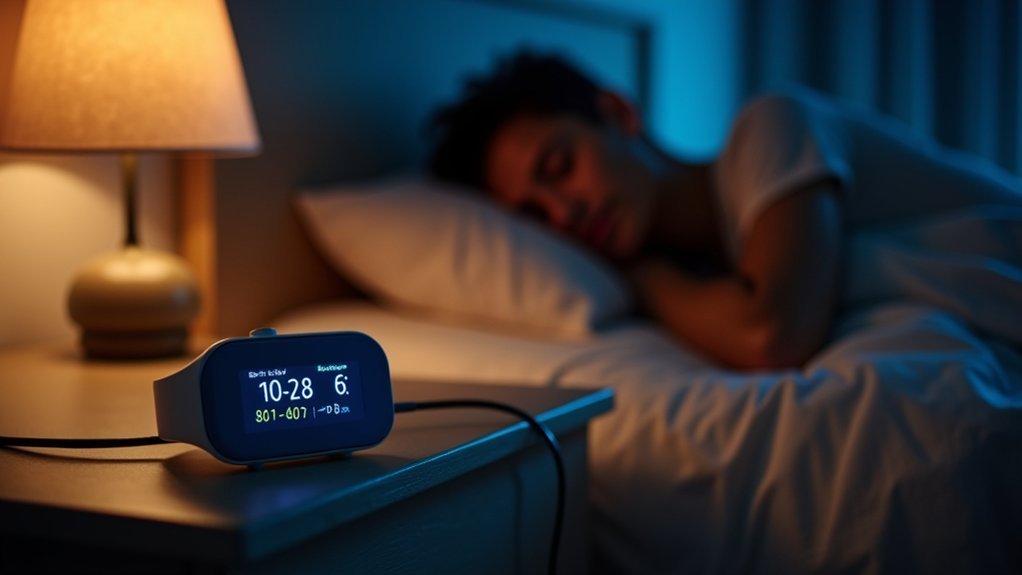

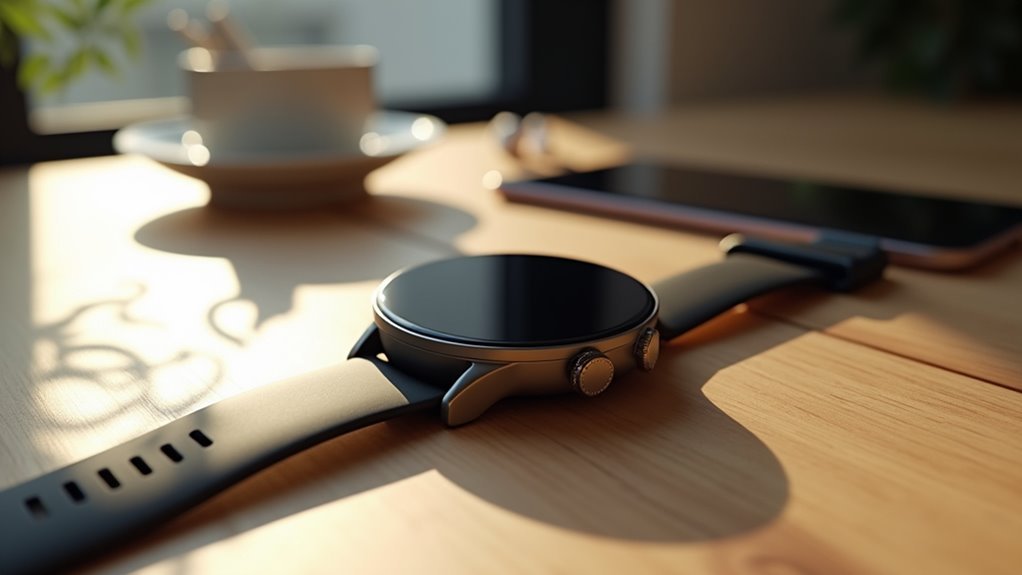
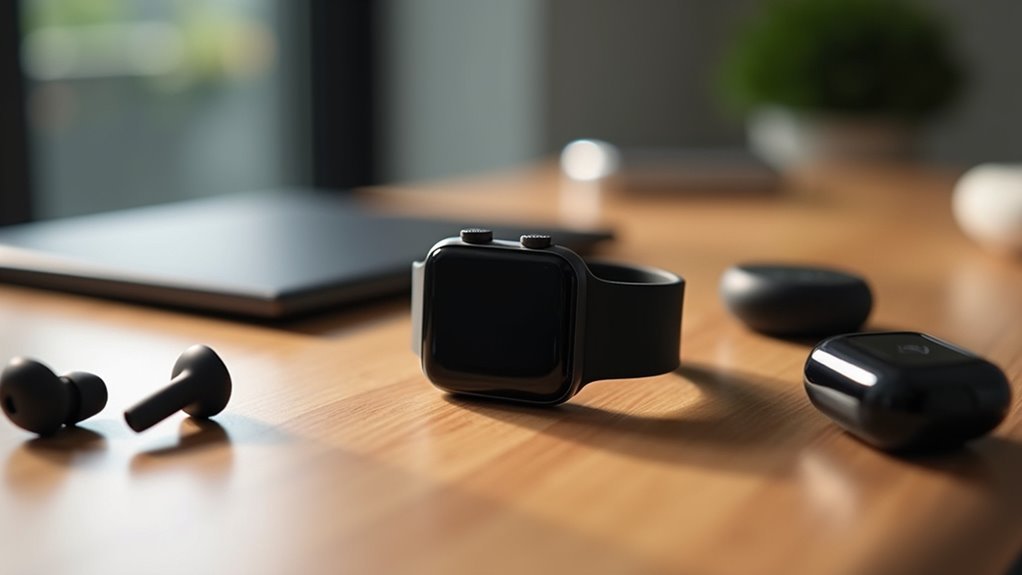
Leave a Reply